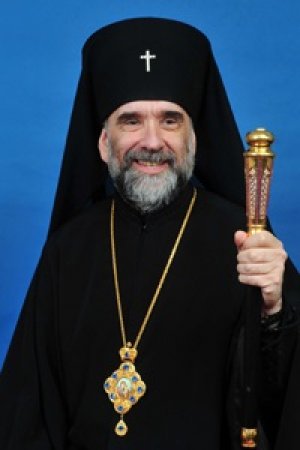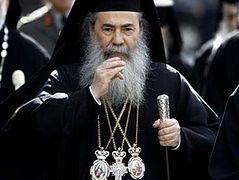Source: Diocese of New York and New Jersey (OCA)
March 7, 2016

Dearly Beloved Members of our Diocesan Family:
Christ is in our midst! – He is and ever shall be!
Let us set out with joy upon the season of the Fast, and prepare ourselves for spiritual combat.
As we begin the sacred season of Great Lent, I am mindful of the Russian term podvig, a very important concept in our Holy Orthodox Tradition. The word podvig can be translated as “spiritual struggle.” It is an aspect of asceticism, a disciplinary way of life, pursued as a means of a higher ideal. In performing a podvig, we find it to be a means of drawing closer to Christ as we travel along the path of salvation.
The great Russian Saint, Theophan the Recluse, defines our entire Christian life as podvig. He explains that while the spirit hates sin, the flesh may actually dwell in it. How then is this battle within ourselves to be resolved? It is resolved through podvig, the spiritual struggle of bringing the soul into mastery over the body. The Church gives us directions for doing this through our prayer rule, participation in divine services and Scripture reading, fasting and abstinence, standing in worship and making prostrations, giving alms to the poor, etc. All of these things strengthen the soul by disciplining the body, and as we fulfill these ascetical practices, we will indeed find that they help us draw nearer to our Creator and Savior. During Lent in particular, we are called to deepen our souls in Christ, to do more, to go beyond what the Church has already told us are the necessary first steps. Podvig is precisely that "doing more.”
In Great Lent, as the Church prescribes, many of us will strive to improve our rule of prayer – which, in the words of Saint Symeon of Thessaloniki, is “conversation directly with God, being always with God, having one’s soul united with Him and one’s mind inseparable” -- through the prescribed words in our prayer books, the saying of the Jesus Prayer, and the pouring out to God of our own requests, intercessions, and confessions. The Church will offer us more divine services to participate in, so that we can draw ever closer to our Savior, Who is the object of our worship. The world, however, with its demands on our time and talents, will tug at us to go in a different direction, and we will indeed have to “struggle” to stay focused on the One Who is the author and finisher of our faith (Hebrews 12:2).
During the Great Fast, many of us will strive to follow the Church’s guidelines and abstain from meat and dairy products for seven weeks. However, Saint John Chrysostom reminds us of an even greater understanding of the Fast – “abstinence not only from food but from sins.” He says, “The fast should be kept not only by the mouth but also by the eye, the ear, the feet, the hands and the other members of the body.” The eye must abstain from impure sights; the ear, from malicious gossip; the hands, from acts of injustice. Our podvig will be to fight the temptations that will come from the media and our own social life … temptations to indulge in foods we have pledged to give up … temptations to succumb to practices, common on the streets, which we have promised to avoid.
The Lenten Season affords us the opportunity to focus on the criteria of judgment on the Last Day, presented to us in the Gospel of Matthew: to express our love for others in practical form – to feed the hungry, to give drink to the thirsty, to welcome the stranger, to clothe the naked, to visit the sick and those in prison. The second century Shepherd of Hermas insists that the money saved from abstaining from rich foods during the feast should be given to the widow, the orphan, and the poor. Because the world will continue to lure us to spend our time and talents and treasures on material possessions, creature comforts and forms of entertainment, we will “struggle” to increase our works of mercy for the least of His brethren, those in need.
The podvig of Lent, our spiritual struggle, is an imitation of the struggles of the Chosen People of the Old Covenant as they wandered in the wilderness for forty years, seeking entrance into the Promised Land. It is a replication of the struggles of the Saints of the New Testament, from the apostles and disciples of the first century to the martyrs and ascetics of our own time and our own country! It is the legacy of the struggles of so many of our grandparents and parents, who took their Faith seriously and held to the practices of Great Lent piously. But most importantly, the spiritual struggle we undertake is homage to the One Who prayed and fasted for forty days and nights, before He began His ministry which would achieve our salvation.
In our Lenten struggle, we are encouraged by Saint Paul in I Corinthians 9:24-26, where he tells us that we need to be spiritually fit, like athletes in training. And in order to do that he urges us in Ephesians 6:10-18: Finally, my brethren, be strong in the Lord and in the power of His might. Put on the whole armor of God that you may be able to stand against the wiles of the devil. For we do not wrestle against flesh and blood, but against principalities, against powers, against the rulers of the darkness of this age, against spiritual hosts of wickedness in the heavenly places…
One might ask, why should we do all of this? Why should we undergo this Lenten “struggle,” this podvig, anyway? The answer is to achieve our goal, the goal not only of Lent but of our entire lifetime – to come closer to Christ, to become more like God, to enter into eternal communion with the Holy Trinity. We want that because we know how much Jesus Christ, our Lord God and Savior, has loved us – with that love greater than any man has, to lay down His life for His friends (John 13:35). And so, let us “Let us set out with joy upon the season of the Fast, and prepare ourselves for spiritual combat” … let us undertake our Lenten podvig … to show our love for the God Who loves more than we love ourselves. To Him be all glory unto ages of ages!
With my humble prayers, Archpastoral blessing and sincere love,
+ M I C H A E L
Archbishop of New York and the Diocese of New York and New Jersey



